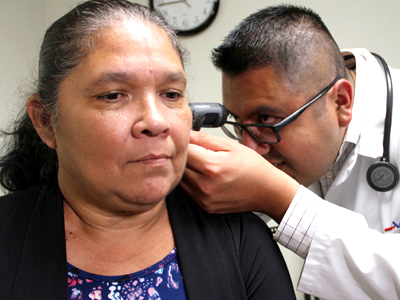
Program trains immigrant doctors in California
The United States has an increasing shortage of doctors that could leave a shortfall of 95,000 physicians by 2025. Up to a third of those could be primary care doctors, often the first line of care for patients. A program at UCLA to train more immigrant Hispanic doctors to practice in California is addressing the nationwide shortage while creating new career opportunities for foreign doctors.
“The UCLA International Medical Graduate Program is designed to take the best and brightest doctors from other countries, put them through additional training at UCLA, then rely on them to care for patients who have very limited access to healthcare,” said Michelle Bholat, MD, executive director and co-founder of the International Medical Graduate Program (IMG). “What’s so unique about our program is that it often means immigrant patients, who are typically underserved in medicine, are cared for by doctors who are new immigrants themselves.”
Dr. Victor Salazar is enjoying his work at the Foothill Community Health Center in San Jose. A father of three kids from Quetzaltenango, Guatemala, Salazar is a surgeon who graduated from medical school in Guatemala and was doing his residency in his hometown when he received his Green Card. He decided to ask for some time off of work to visit his mother in Los Angeles. During that visit in 2006, Salazar learned that UCLA was recruiting doctors and decided to apply. Following numerous tests and interviews, he was accepted to be trained under the UCLA program.
“The program is a blessing”, says an excited Salazar. “It is not easy to become a doctor here in United States, but it is not impossible. They train you very well not only to pass the exams but to obtain high grades, which make you attractive to get a good job in the hospital.”
After finishing several exams and programs, Salazar was hired by Kern Medical Center in Bakersfield – he did his residency there and after three years was offered a position at Foothill Community Health Center in San Jose. Accepting the job was part of a commitment to serve the community for three years -- after finishing his commitment of three-years, Salazar decided to continue at the Center.
“I receive a salary and most important I receive the satisfaction to know that we are helping the community – my patients are undocumented or low income with an insurance that does not cover a lot. I share and believe the mission to help people in need.”
Salazar is now Associate Medical Director at the Center and manages 14 clinics that see 22,000 to 25,000 people per month.
“I love the labor that we are doing and I have had the opportunity to hire doctors with the same vision,” he says. “There are not a lot of Hispanic doctors so through the program they want to motivate more people to become doctors and help the community.”
In exchange for the UCLA medical training that helps them pass their U.S. licensing exams and obtain U.S. residency training in Family Medicine, doctors who complete the IMG program agree to work in underserved communities for two to three years. Often, after their obligation to serve in underserved communities is complete, doctors choose to stay.
“Of all the individuals who have graduated from our program, who could go work wherever they wanted to after meeting their requirements, 75 percent of them remained in the underserved communities,” said Bholat. “That is a remarkable statistic and is a win-win for the doctors and their patients who so desperately rely on their care.”
After graduating from the IMG Program last year, Dr. Jose Javier Hernandez, from Oaxaca, Mexico, is now a first-year resident in the family medicine residency program at Adventist Health in Hanford, which is located in rural Kings County, California. Spanish-speaking immigrant farm workers make up a large portion of the population and the doctor to patient ratio is 2,500 to one.
“The need for medical care here is overwhelming,” said Hernandez. “It’s so rewarding knowing how much of a difference I am making in their lives.”

